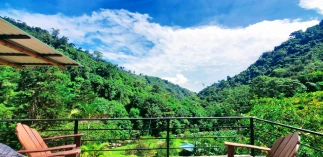High in the Costa Rican mountains, where the air chills and the emerald cloak of the rainforest thins, a secretive songbird weaves through the dense undergrowth. This elusive fellow is the Mourning Warbler, a small but fascinating resident in our mountain retreat’s ecosystem.
While their name might evoke images of somber plumage, Mourning Warblers are a study in subtle elegance. Males sport a handsome combination of olive green above and a bright yellow below, offset by a charcoal-gray hood. The true star of the show, however, is the jet-black patch adorning their throat and chest – a bold statement against their otherwise muted tones. Females and immature Mourning Warblers are even more cryptic, opting for a blend of brownish-gray above and a softer yellow below.
Despite their vibrant attire, spotting a Mourning Warbler is a challenge. Nicknamed the “fugitive” species by some ornithologists, these birds are notorious skulkers. They flit through the dense understory, preferring the tangled embrace of raspberry thickets and brushy clearings to the open branches. Their small size and preference for low vegetation make them masters of camouflage.
But don’t let their shyness fool you – Mourning Warblers are vocal residents of the mountain forests. Listen for their distinctive song, a short, burbling series of “churry” notes that rolls through the undergrowth. It’s a simple melody, but one that serves as a beacon to attentive birders, hinting at the hidden world below the canopy.
While primarily a summer resident in the mountainous regions of Costa Rica, some Mourning Warblers may linger through the winter, particularly in sheltered areas with abundant brush. If you’re patient and observant during your stay at our mountain retreat, you might just be lucky enough to catch a glimpse of this little gem flitting through the understory.
Here are some tips for enhancing your chances of encountering a Mourning Warbler:
- Time your birding walks for the early morning or late afternoon. These are peak foraging times for the warbler, and they might be more active and vocal.
- Focus on areas with dense, low vegetation. Look for thickets, clearings with plenty of brush, and forest edges where sunlight filters through.
- Train your ears. The Mourning Warbler’s song is their giveaway. Once you familiarize yourself with it, you’ll be better equipped to locate these shy birds.
A sighting of a Mourning Warbler is a reward for the patient birder. It’s a testament to the hidden wonders that reside within the lush embrace of Costa Rica’s mountain forests. So, keep your eyes peeled and your ears tuned – with a bit of luck, you might just unlock the secrets of this captivating songster.
For more information, please view our comprehensive guide about the birds of Costa Rica







